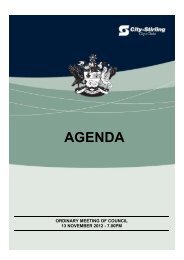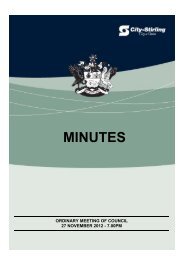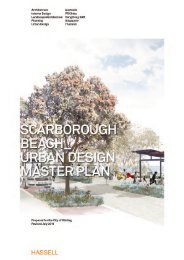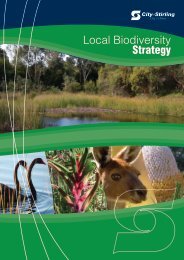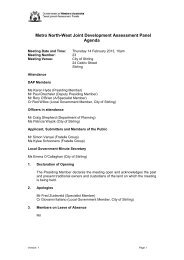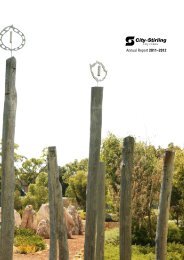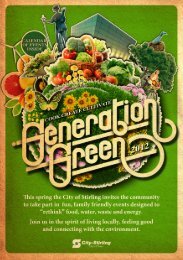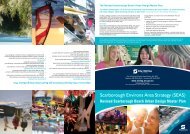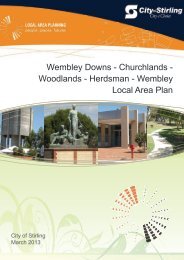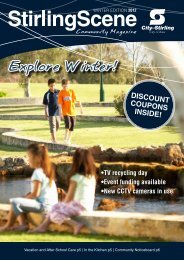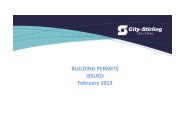KARRINYUP / GWELUP Local Area Plan - City of Stirling
KARRINYUP / GWELUP Local Area Plan - City of Stirling
KARRINYUP / GWELUP Local Area Plan - City of Stirling
Create successful ePaper yourself
Turn your PDF publications into a flip-book with our unique Google optimized e-Paper software.
<strong>Plan</strong>ning Context<br />
The planning frameworks that are in place over the Perth Metropolitan <strong>Area</strong> and the <strong>City</strong><br />
<strong>of</strong> <strong>Stirling</strong> must be accounted for as part <strong>of</strong> <strong>Local</strong> <strong>Area</strong> <strong>Plan</strong>ning. This helps to ensure that<br />
the <strong>Plan</strong> is consistent with broader policy and strategic objectives and enables us to<br />
achieve these.<br />
State Sustainability Strategy<br />
Hope for the Future: The Western Australian State Sustainability<br />
Strategy has been developed to facilitate a whole‐<strong>of</strong>‐government<br />
approach to promote sustainability in government, private sector<br />
and community activities. <strong>Local</strong> <strong>Area</strong> <strong>Plan</strong>ning similarly aims to<br />
address community, environmental and economic needs in an<br />
integrated manner. <strong>Local</strong> <strong>Area</strong> <strong>Plan</strong>ning can contribute to the<br />
realisation <strong>of</strong> the State Sustainability Strategy objectives through<br />
the development <strong>of</strong> sustainability and regeneration initiatives;<br />
facilitating the creation <strong>of</strong> a high‐quality built environment and<br />
public places which contribute to the development <strong>of</strong> a strong<br />
sense <strong>of</strong> place; building social capital though public participation in<br />
plan‐making; and by focusing on partnership‐building between<br />
State and local governments and other institutions.<br />
State <strong>Plan</strong>ning Strategy<br />
The State <strong>Plan</strong>ning Strategy (1997) is prepared and administered<br />
by the Western Australian <strong>Plan</strong>ning Commission and the<br />
Department for <strong>Plan</strong>ning and Infrastructure to guide planning,<br />
development, resource protection and conservation across the<br />
State. The Strategy sets out criteria for plans such as <strong>Local</strong> <strong>Area</strong><br />
<strong>Plan</strong>s in order to deliver on Strategy objectives. These include<br />
the encouragement <strong>of</strong> mixed‐use development, a range <strong>of</strong><br />
housing densities and public transport use; developing central<br />
community focal points; ensuring that community engagement<br />
occurs in the planning process; and that environmental issues<br />
are considered in plan preparation.<br />
The three interrelated pillars<br />
<strong>of</strong> sustainability<br />
Metropolitan Region<br />
Scheme<br />
The Metropolitan Region<br />
Scheme (1963) is the<br />
overarching statutory planning<br />
scheme for the Perth<br />
metropolitan region and<br />
establishes provisions for<br />
development control across<br />
the region. <strong>Local</strong> government<br />
schemes are to be consistent<br />
with zonings <strong>of</strong> the MRS.<br />
Network <strong>City</strong><br />
Network <strong>City</strong>: Community <strong>Plan</strong>ning Strategy for Perth and Peel was released in<br />
2004 to guide planning and development over the region for the next 30 years.<br />
The Strategy was developed in response to anticipated population growth,<br />
changing community expectations <strong>of</strong> the planning system, and the need for a<br />
more sustainable Perth region. Network <strong>City</strong> is based on reinforcement or<br />
development <strong>of</strong> ‘activity corridors’ (major roads with good public transport<br />
where activity clusters) and ‘activity centres’ (key commercial and employment<br />
centres), with land use, housing and transport systems developed to support<br />
this network. The Strategy was also developed through participatory decisionmaking<br />
and advocates this approach as part <strong>of</strong> future plan development.<br />
Network <strong>City</strong> objectives that are relevant to <strong>Local</strong> <strong>Area</strong> <strong>Plan</strong>ning include:<br />
• Accommodate urban growth primarily within a network city pattern;<br />
• Align transport systems and land use to optimise accessibility and amenity;<br />
• Protect and enhance the natural environment, open spaces and heritage;<br />
and<br />
• <strong>Plan</strong> with the communities.<br />
Bush Forever<br />
Bush Forever is a State government<br />
strategy for the conservation <strong>of</strong><br />
bushland and natural environments<br />
across Perth. The Strategy aims to<br />
protect ten percent <strong>of</strong> each <strong>of</strong> the 26<br />
different types <strong>of</strong> vegetation complexes<br />
originally found on the Swan Coastal<br />
Plain, and to conserve threatened<br />
ecological communities. The Strategy<br />
identifies valued public or privately<br />
owned sites across the region that<br />
should be reserved, maintained or<br />
rehabilitated for conservation and/or<br />
recreation purposes.<br />
Network <strong>City</strong> ‐ Conceptual Map<br />
CITY OF STIRLING 16<br />
<strong>KARRINYUP</strong>-<strong>GWELUP</strong> LOCAL AREA PLAN<br />
February 2010



